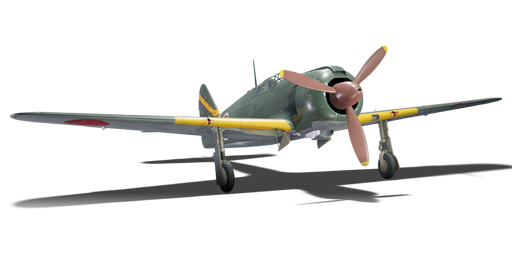



The Ki-100 is a Japanese fighter. It was introduced in Update 1.61 "Road to Glory". Based on the Ki-61-II, the Ki-100 features a new Ha-112-2 radial engine that allows a faster rate-of-climb, allowing the Japanese to contest Allied bombing raids on their home islands in 1945.
The default camo bears the insignia of the 59th Sentai, formed in 1938, it participated in key operations during the Sino-Japanese War and Pacific Theatre. After being stationed in Java, they defended Palembang and attacked Port Darwin before moving to New Guinea, where they faced difficulties against the P-38 in the Ki-43-II. Following heavy losses and the death of Captain Shigeo Nangō in 1944, the unit returned to Japan, reequipped with the Ki-61 "Hien" and took up air defence duties in Northern Kyushu. By late 1944, they formed a kamikaze unit, stationed part of their force on Jeju Island, and continued air defence and kamikaze escort missions from Chiran. Later, in 1945 they transitioned to the Ki-100 and defended Northern Kyushu until the end of the war.
In the game, the Ki-100 continues to exhibit the Ki-61's relatively balanced characteristics in speed, dive performance, climb rate, manoeuvrability, and armaments. While not particularly excelling in any trait, it does allow the player more options to contest the airspace.
flaps
flaps
flaps
brake
| Belt | Belt filling | Armor penetration (mm) at a distance: | |||||
|---|---|---|---|---|---|---|---|
| 10 m | 100 m | 500 m | 1000 m | 1500 m | 2000 m | ||
| HEF-I/P/AP-T | 27 | 25 | 17 | 10 | 6 | 4 | |
| HEF-I/HEF-I/AP-T | 27 | 25 | 17 | 10 | 6 | 4 | |
| AP-T/AP-T/HEF-I | 27 | 25 | 17 | 10 | 6 | 4 | |
| AP-T | 27 | 25 | 17 | 10 | 6 | 4 | |
| HEF-I/HEF-I/HEF-I/P | 16 | 13 | 8 | 6 | 0 | 0 | |
| Belt | Belt filling | Armor penetration (mm) at a distance: | |||||
|---|---|---|---|---|---|---|---|
| 10 m | 100 m | 500 m | 1000 m | 1500 m | 2000 m | ||
| AP-T/AP/HEF-I | 21 | 19 | 13 | 7 | 4 | 3 | |
| AP-T/HEF-I/AP/HEF-I | 21 | 19 | 13 | 7 | 4 | 3 | |
| AP-T/HEF-I/HEF-I/HEF-I | 21 | 19 | 13 | 7 | 4 | 3 | |
| AP-T/AP/AP-T | 21 | 19 | 13 | 7 | 4 | 3 | |
| AP/HEF-I/HEF-I/HEF-I | 21 | 19 | 13 | 7 | 4 | 3 | |












Flight performance | |
|---|---|
Survivability |
|---|
Weaponry | ||
|---|---|---|